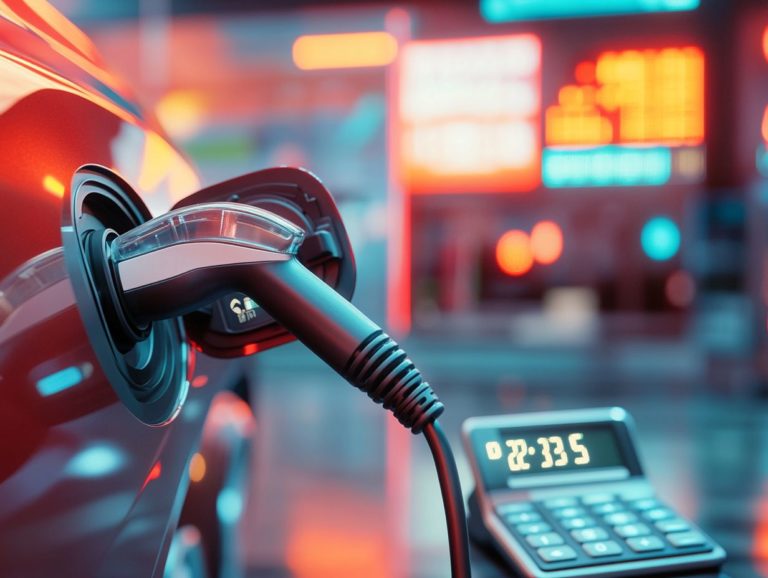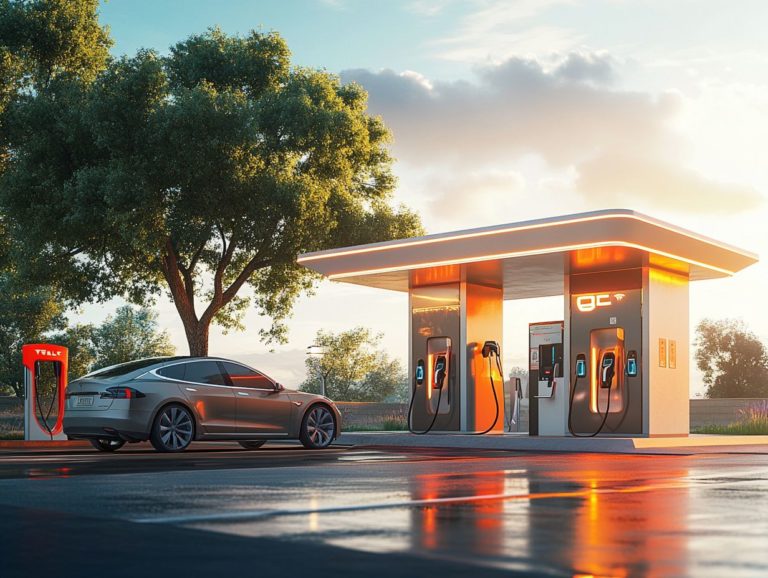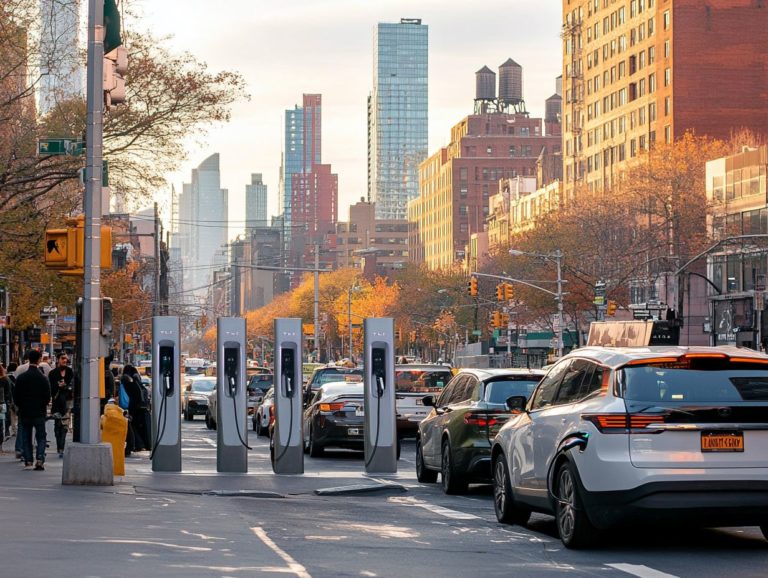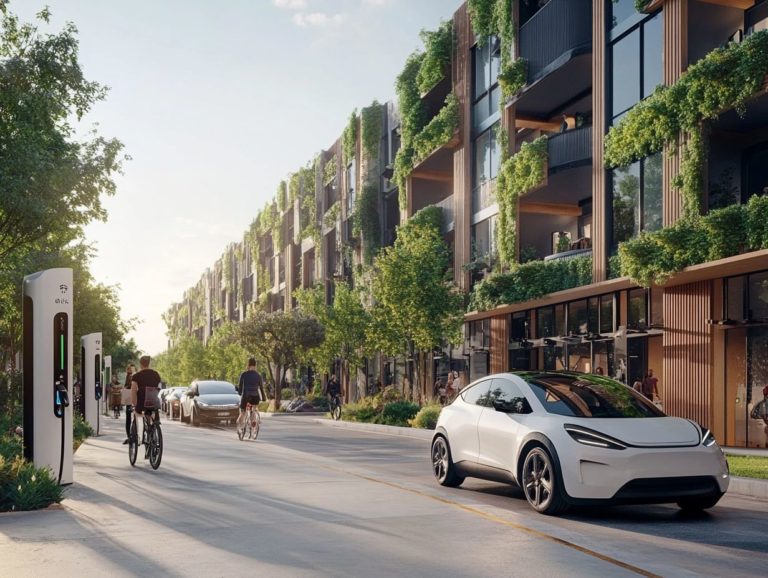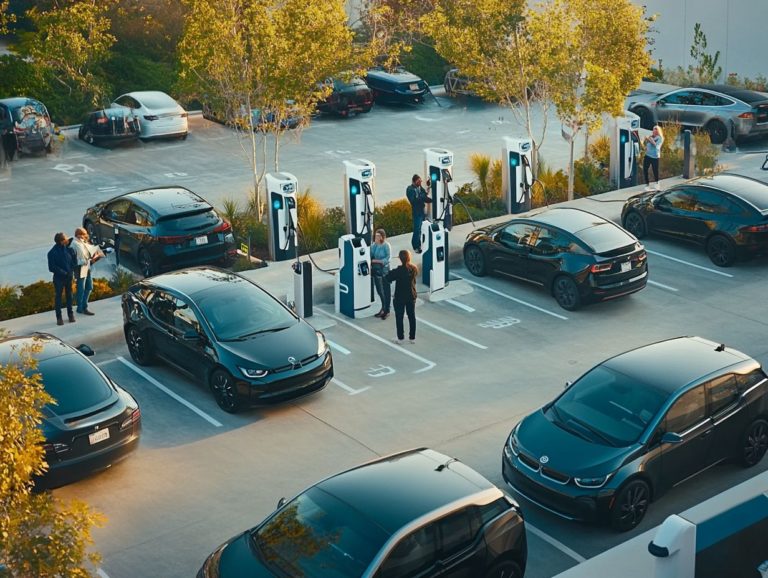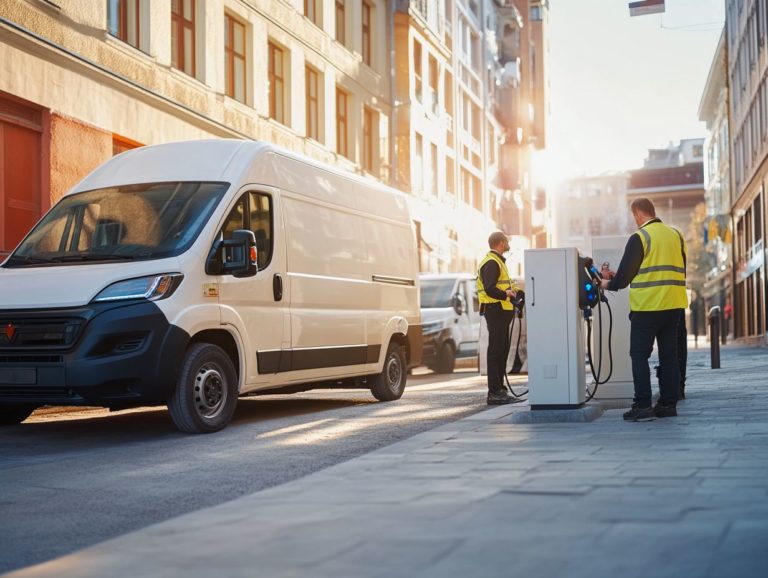How to Evaluate EV Charging Solutions
As electric vehicles (EVs) rise in popularity, understanding the various charging solutions available is crucial for both individuals and business owners.
Let’s dive into the exciting world of EV charging solutions! This article explores different types of EV charging options, from home installations to public networks. It highlights key factors to consider, such as cost, compatibility, and charging speed.
By comparing the pros and cons of each solution, you’ll be ready to choose the ideal charging setup that meets your needs, ensuring you’re fully prepared for the electric future ahead.
Contents
- Key Takeaways:
- Understanding EV Charging Solutions
- Factors to Consider when Evaluating EV Charging Solutions
- Comparing Different EV Charging Solutions
- Selecting the Right EV Charging Solution for Your Needs
- Frequently Asked Questions
- What are the key factors to consider when evaluating EV charging options?
- How can I determine the charging speed of an EV charger?
- What types of charging stations are available for EVs?
- Are all EV chargers compatible with all EV models?
- What other costs should I consider when evaluating EV charging options?
- How do I determine the most convenient location for an EV charger?
Key Takeaways:
- Research and understand the different types of EV charging options to find the most suitable one for your needs.
- Evaluate charging solutions based on compatibility, speed, and network support to make informed decisions.
- Compare the pros and cons of each EV charging option, keeping future growth and upgrades in mind.
Understanding EV Charging Solutions
Understanding EV charging solutions is important for consumers and businesses alike as the adoption of electric vehicles (EVs) skyrockets. A well-designed charging setup enhances the customer experience and ensures smooth operations for electric vehicle fleets.
With many options available, you’ll need to navigate the landscape of various charging equipment, such as Level 2 chargers and public charging stations. Keep installation needs, budget constraints, and compliance requirements in mind as you make decisions.
Utilizing federal incentives can help speed up your project timeline and reduce costs associated with establishing a robust charging network.
Types of EV Charging Options
You have numerous EV charging options to explore, each tailored to different charging needs. Level 2 chargers are ideal for home and workplace use, striking a balance between charging speed and installation costs.
On long journeys, public charging stations become essential, offering reliable access to charging no matter where you are.
DC fast charging solutions deliver electricity at lightning speed, drastically reducing your charging time. For quieter nights, trickle chargers provide a slow but steady charge perfect for overnight residential use.
For those frequently on the go, battery swap stations allow quick exchanges of depleted batteries for fully charged ones, minimizing downtime. Also, solar-powered chargers are an eco-friendly option that lets you harness renewable energy while charging.
These charging solutions cater to various preferences, from the need for rapid recharging to sustainable energy options, ensuring you can find the right fit for your lifestyle.
Factors to Consider when Evaluating EV Charging Solutions
When evaluating EV charging solutions, several critical factors ensure optimal performance and customer satisfaction. Start with a thorough assessment of installation needs, including site evaluations and any necessary electrical upgrades.
Compatibility with different vehicle models is crucial, as various EVs may have distinct charging requirements. Charging speed and efficiency significantly impact the overall user experience.
Consider the importance of network availability and maintenance support, as these factors influence long-term operational costs and reliability.
Cost and Installation Requirements
Understanding costs and installation requirements is vital for anyone implementing EV charging solutions effectively. Installation costs can vary widely based on the type of charging equipment chosen and the complexity of logistics involved. It’s essential to consider budget constraints and how federal incentives might alleviate financial burdens.
Several factors influence your overall cost. Opting for high-speed chargers may require a higher initial investment, but they can deliver quicker charging times and increase usage rates.
Installation logistics vary based on location and existing electrical setups. Labor costs and site preparation differ significantly, and ownership models—whether public or private—carry their own financial implications.
Budget constraints can restrict choices and impact long-term sustainability, highlighting the importance of meticulous planning and evaluating available financial incentives for maximum value.
Compatibility with Vehicle Models
Compatibility with vehicle models is a critical factor shaping your charger selection and overall customer experience. Different electric vehicles come with specific charging connectors and protocols, making thorough research essential to ensure your chosen type meets the needs of EV users.
For example, popular electric vehicles like the Tesla Model 3 and Nissan Leaf each have unique charging requirements. The Tesla uses its proprietary connector for easy access to its extensive Supercharger network, while the Nissan Leaf utilizes standard J1772 connectors for Level 2 charging.
This variety shows how crucial it is for operators and homeowners to consider different charging speeds and connector types when investing in charging solutions. Doing so ensures a wider audience and elevates the overall electrification experience.
Charging Speed and Efficiency
Charging speed and efficiency are key measures for assessing the effectiveness of EV charging solutions.
Quickly refueling your electric vehicle alleviates charging anxiety, significantly enhancing the convenience of owning an EV. As you seek sustainable options, the energy efficiency of charging solutions becomes paramount; efficient chargers minimize energy waste and reduce greenhouse gas emissions.
By evaluating performance metrics like kilowatts delivered per hour and charge times, you gain insights into how different options compare. This assessment is essential for making informed decisions that align with your financial and environmental goals.
Network and Maintenance Support
Robust network and maintenance support are vital components of a successful EV charging solution. As electric vehicles gain traction, having a reliable networked charging system can elevate the customer experience by providing seamless access to stations.
Regular maintenance is crucial for ensuring optimal functionality and longevity of charging equipment. Establishing clear service agreements with partners can streamline maintenance processes, ultimately reducing costs and minimizing downtime.
The significance of these support systems cannot be overstated, especially when user experience is on the line. Imagine arriving at a station only to find it out of order; effective network support ensures quick fixes to avoid hassle.
Periodic maintenance checks identify potential issues before they escalate, ensuring smooth charging operations. This leads to increased user satisfaction and builds trust in the overall charging infrastructure.
Comparing Different EV Charging Solutions
Comparing various EV charging solutions is essential for stakeholders seeking to optimize efficiency and enhance customer satisfaction in charging infrastructure investments.
Whether it’s Level 2 chargers, DC fast charging stations, or public charging networks, each option carries unique advantages and drawbacks that impact operational costs and user experience. Evaluating these differences helps you make informed decisions tailored to your specific needs.
Pros and Cons of Each Option
Each EV charging solution has its own advantages and disadvantages that can significantly affect your operational costs and customer experience. Level 2 chargers are affordable and accessible, making them a great choice for residential and commercial setups, although their slower charging speed may not suit everyone.
On the other hand, DC fast chargers offer rapid charging capabilities, ideal for those on the go, but they often involve higher installation costs and maintenance requirements. Weigh the convenience of each option; Level 2 chargers provide reliable overnight charging but may not meet everyone’s needs for quick stops.
DC fast chargers allow drivers to recharge in mere minutes, making them excellent for long journeys, but availability can be limited on some routes. Additionally, public charging networks often impose varying fees, impacting overall costs. Consider these factors carefully when determining the best solution for your unique needs.
Selecting the Right EV Charging Solution for Your Needs
Choosing the right EV charger involves assessing key factors like your specific charging requirements, budget limitations, and the overall scope of your project.
By thoroughly evaluating available charging solutions, you can pinpoint the charger that best aligns with your operational efficiency and customer experience objectives.
Prioritize user satisfaction by considering how each option corresponds with your distinct goals and requirements.
Assessing Your Specific Requirements
Assessing your specific requirements is a crucial first step in identifying the most suitable EV charging solution. Evaluate factors like site conditions, installation costs, and the charging needs of your fleet. Collaborating with project partners can yield invaluable insights for tailoring solutions that align with your objectives and ensure a seamless customer experience.
If you manage a large fleet, you might prioritize fast charging solutions to minimize downtime. Conversely, a residential setting may lean toward home charging stations offering the ultimate convenience. Knowing peak usage times and existing infrastructure can greatly affect your decisions.
A thorough assessment helps you sidestep common pitfalls and select a charging solution that boosts operational efficiency, aligns with sustainability goals, and adheres to regulatory requirements. This approach enhances operations and builds trust with users.
Considering Future Growth and Upgrades
When planning your EV charging infrastructure, consider future growth and upgrades. The electric vehicle market is evolving, and scalability is essential for adapting to new technologies and rising demand. Investing in energy-efficient charging options future-proofs your infrastructure while minimizing operational costs and enhancing performance.
This foresight supports a growing fleet of electric vehicles and aligns with sustainability goals that consumers and regulators increasingly prioritize. Integrating smart charging technologies can enhance your charging experience by enabling real-time adjustments based on grid demand and renewable energy availability, significantly amplifying efficiency.
Prioritizing scalable designs, like modular charging stations, allows you to expand capabilities seamlessly. Whether catering to a growing customer base or enhancing services, thoughtful planning around scalability and energy efficiency elevates operational effectiveness and strengthens your long-term success in the rapidly shifting landscape of electric mobility.
Frequently Asked Questions
What are the key factors to consider when evaluating EV charging options?
When evaluating EV charging options, consider factors such as charging speed, compatibility with different EV models, cost, and ease of use. Assess the availability of charging stations in your area and the type of charger that best suits your EV’s battery.
How can I determine the charging speed of an EV charger?
The charging speed of an EV charger is typically measured in kilowatts (kW). Note that the speed may vary based on the type of charger and the EV’s battery capacity. A higher kW rating indicates a faster charging speed.
What types of charging stations are available for EVs?
There are three main types of EV charging stations: Level 1, Level 2, and DC fast chargers. Level 1 chargers use a standard 120-volt outlet and are usually the slowest option. Level 2 chargers use a 240-volt outlet for faster charging speeds. DC fast chargers, or Level 3 chargers, use high-voltage direct current and can charge an EV to 80% in about 30 minutes.
Are all EV chargers compatible with all EV models?
No, not every EV charger works with all EV models. Some chargers are designed for specific brands or models, while others are more universal. It is important to check compatibility before making a purchase.
What other costs should I consider when evaluating EV charging options?
In addition to the initial cost of the charging station, consider installation fees, any necessary upgrades to your electrical system, and ongoing maintenance costs. Research potential rebates or incentives for purchasing an EV charging solution.
How do I determine the most convenient location for an EV charger?
Think about your daily routine. Do you prefer charging at home overnight, at work, or during outings? Choose the location that fits your lifestyle best.

.jpg_00.jpeg)
.jpg_01.jpeg)
.jpg_10.jpeg)
.jpg_11.jpeg)
